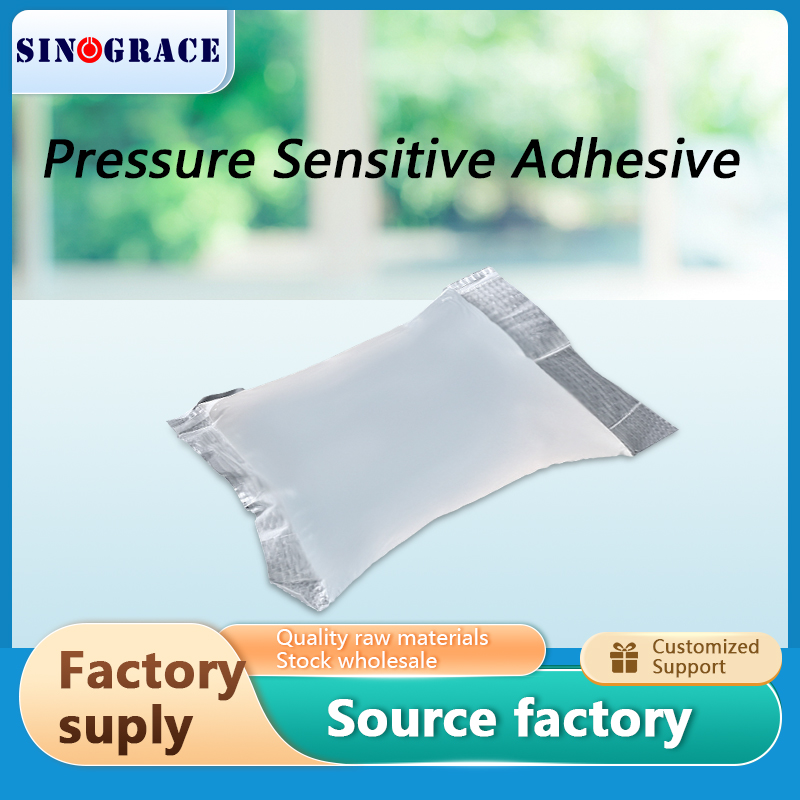Pressure sensitive adhesive (PSA) is a self-adhesive material, only need to apply a small pressure, can form a van der Waals force on the surface of the two objects, and the adhesive is firmly bonded, this pressure sensitive bonding performance is its basic feature, is also different from other adhesives typical characteristics.
PSA can be divided into solution type, emulsion type, photocuring type and hot melt type.Solution PSA contains flammable and toxic organic solvents, which is easy to cause environmental pollution. Emulsion PSA dries slowly and the coating process is complicated.
Performance advantages of hot melt pressure sensitive adhesive
Hot melt pressure sensitive adhesive (HMPSA) has become a popular adhesive product due to its advantages of no solvent, environmental protection, simple preparation, low cost, etc., involving in all aspects of daily life, including daily chemical, medical, automotive, home, label, packaging, wood processing and shoe making.
Common hot melt pressure sensitive adhesive classification
Thermoplastic elastomer HMPSA
Thermoplastic elastomer HMPSA is a mixture of thermoplastic elastomer, adhesive resin, plasticizer, antioxidant and filler. Thermoplastic elastomers mainly refer to styrene and its block copolymers, commonly used such as styrene-butadiene block (SBS) and styrene-isoprene block (SIS), which have a wide range of sources, reasonable prices, thermoplasticity at high temperature, and the elasticity of rubber at room temperature.
Compared with other hot-melt pressure-sensitive adhesives, thermoplastic elastomer hot-melt pressure-sensitive adhesives have the advantages of good cohesion, small melt viscosity, strong adhesion and mature process development.
However, due to the low polarity of SBS and SIS molecules and the existence of unsaturated double bonds, the traditional thermoplastic elastomer HMPSA has some shortcomings, such as low bonding strength to polar materials, poor oil and solvent resistance and insufficient heat resistance to oxygen aging. In order to better meet the performance requirements of users on SIS based hot melt pressure-sensitive adhesive, researchers have modified it by various ways, including SIS thermoplastic elastomer modification, tackifying resin modification, physical blending modification.
Acrylates HMPSA
The monomers of acrylate HMPSA mainly include flexible monomer, hard monomer and functional monomer. The flexible monomer has viscosity and the glass transition temperature (Tg) is low. The hard monomer has high Tg, provides adhesive viscosity and cohesion, and significantly improves water resistance and transparency; Functional monomers contain double bonds and cross-link with other monomers to promote polymerization, speed up reaction rate and improve stability.
Compared with other HMPsas, acrylic HMPSA has excellent weather and heat resistance without the use of viscosity enhancing resins and antioxidants.

Silicone HMPSA
Silicone HMPSA has a broad application prospect, in addition to the good performance of HMPSA itself, but also has outstanding high and low temperature resistance, electrical performance and chemical resistance.
Polymers used for organosilane HMPSA include polydimethylsiloxane, polymethylphenyl siloxane, polydimethyldiphenyl siloxane, and other polysiloxane polymers including various organosiloxanes.
Amorphous polyolefin HMPSA
Amorphous polyolefin is essentially a low relative molecular weight homopolymer or copolymer of propylene or propylene copolymerized with ethylene, butene and hexene at low pressure. HMPSA made of amorphous polyolefin has the advantages of low cost, low softening point and small melting viscosity, outstanding high and low temperature resistance, long storage time, and good adhesion to metal, wood, paper, polyethylene and polypropylene.
Rubber type HMPSA
In recent years, rubber HMPSA has been developed, mainly composed of rubber (including natural rubber and synthetic rubber), adhesive resins, plasticizers and appropriate fillers, with simple production, no pollutant emissions, belonging to the environmental friendly adhesive. Compared to the traditional SBS/SIS type HMPSA, the rubber type HMPSA has better low temperature resistance and better wettability to the PE substrate, in addition to relatively good water and oil resistance.

 English
English français
français русский
русский español
español العربية
العربية





